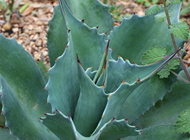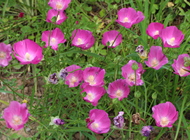 |
Garden journal entry |
 |
| September 10, 2017. Look out from any house in our subdivision into the backyard and you're likely to see an expanse of grass right up to the cedar slat privacy fence that separates all our backyards from each other. Especially in as new a neighborhood as ours, there's just not much "garden" in those yards yet. But I'm trying to rid our yard of that look, which is particularly unattractive to me – so I've been chipping away at the extent of the line along which lawn and fence meet. As part of April's pond installation project, I tackled the entire back fenceline, so that there is now anywhere between about 3 ft and 8 ft of gardenable border between the lawn and the fence. But the fencelines on both sides still need work. This weekend, after the nursery trip I talked about a couple days ago, I had a couple of plants left without an obvious spot in the existing garden borders, so that was an excellent excuse to continue project lawn-away. The target of my efforts was a stretch along the left fenceline, between the back corner where we had planted two fig trees last fall and a lonesome seed-starting bed further down along the fence that had become overrun with weeds. The two needed to be connected, with some good edging in place to prevent continued infestation. Since moving here, I have come to realize that by far my wickedest weed is the bermudagrass that our development insisted on having planted in all the yards. As a northerner, I was not initially aware of its aggressively invasive tendencies, expanding its territory both with aboveground runners that root wherever they touch soil, and with underground rhizomes that can go for several feet before popping up in unexpected places. Keeping the lawn in its place is a daunting task, and a nearly impossible one without a physical barrier to keep at least the sneaky underground invasion at bay. So I've become a good customer of outlets selling plastic edging products, and have gotten rather efficient at installing such products; I'm still dealing with the aftermath of my originally lax methods, with bermudagrass sprigs emerging here and there and everywhere in most garden areas. It gives me great satisfaction when I manage to pull up a long length of rhizome, knowing that I'm that much closer to getting the scourge under control. But I don't fool myself into believing it will ever be truly under control – mindful of the diabolical ways of the pretty creeping bamboo that threatened to overrun our Pennsylvania garden, I know that these kinds of weeds always find a way. What's worse, remember what's behind those fences that run behind the garden borders? Right: the neighbors' lawns. Bermudagrass doesn't respect property lines... Consequently, the backs of those borders are where new infestations pop up most of all. Till now, I had stacked some bricks along our fenceline to serve as a makeshift border, but they hardly deter the devilish grass. So for this latest stretch of border I took a new approach: I cut a 9-inch-wide strip of heavy butyl rubber liner left over from our swimming pond project more than 10 years ago, and tacked it to the bottom of our fence, The rubber extends into the soil, hopefully deep enough to deter wandering roots, while the tack line is hidden by a simple row of bricks arranged along the back of the border. We'll see how effective this is - if it works, I may implement it in more areas (there's plenty more rubber liner!). A side benefit of the border construction: I managed to bury the contents of our tumbling composter, which had devolved into a black maggot-ridden stringy mess without any tendency to turn into crumbly compost, in the bottom of the newly dug border, giving a fresh start to the attempt at composting. Seems like everything's a project, everything's an experiment. Kind of like my day job, really... |
Visitors to this page have left the following comments| Jeanette | Sep 16, 2017 | Wow, what a job! |
|
|